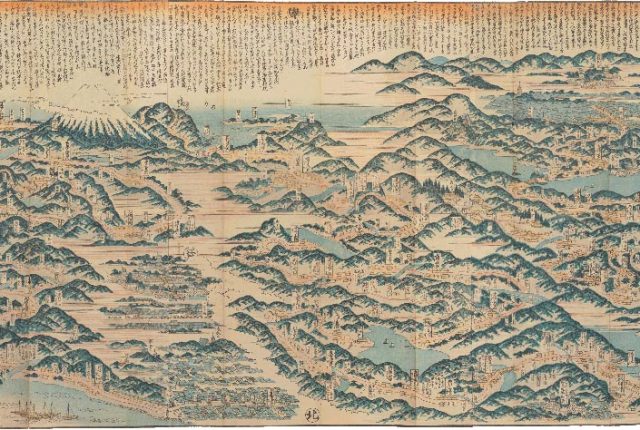
Date/Time
Friday, October 13, 2023
10:00 am PDT – 5:00 pm PDT
Location
UCLA William Andrews Clark Memorial Library
2520 Cimarron Street
Conference organized by Kristopher W. Kersey, University of California, Los Angeles
The subject of this initial conference is the longstanding myth that Japan was hermetically sealed from the rest of the world from the 1630s to 1853. While international travel and trade were indeed forbidden, Japan remained networked with those beyond its shores through trade with the continent, the Dutch, the Ainu, and the Ryūkyūs. During this period, fantasies of Japan proliferated abroad, just as fantasies of the outside world proliferated in Japan. Yet the restrictions on international exchange did not mean that Japan was somehow isolated from modernity. In fact, the metropolis of Edo actually exhibited many of the aspects that would later come to be seen as “modern” by the European definition of the term. Put more forcefully, early modernity seemed to thrive in a society that eschewed the Eurocentric model of “globalization.” Likewise, one should not conflate the Edo metropolis with the eponymous era, for an exciting feature of early modern Japan is the existence of multiple metropolitan centers, from Osaka and Kyoto to Nagasaki. This initial conference will reframe the Edo period in more porous, global, networked, and dynamic terms.
Speakers
Rebekah Clements, ICREA & Autonomous University of Barcelona
Caitlin Karyadi, University of Hong Kong
Drisana Misra, Cornell University
Anton Schweizer, Kyushu University
Timon Screech, International Research Center for Japanese Studies (Nichibunken), Kyoto
Akiko Walley, University of Oregon
About Open Edo: Diverse, Ecological, and Global Perspectives on Japanese Art, 1603–1868
The art of Japan’s Edo period (1603–1868) presents a paradox. On the one hand, the nineteenth-century proliferation of ukiyo-e—polychrome woodblock prints of the “floating words” of theater and sex work—made the popular visual culture of this city a familiar component of modern art in the nineteenth and twentieth centuries. Yet the outsize fascination with ukiyo-e outside Japan has sorely obscured Edo’s far more diverse social, material, and artistic landscapes. In an effort to countervail the enduring stereotypes of early modern Japanese art, Open Edo will present a suite of conferences addressing three interlinked themes: the representation and agency of marginalized groups, the ecological horizons of artistic production, and the ongoing need to counter the myth that Japan in early modernity was somehow disconnected from the rest of the world. Throughout the year-long series, the focus will be both historical and historiographical inasmuch as Open Edo asks how Japanese art history might challenge the discourse of early modernity writ large.
Program Schedule
9:30 a.m.
Morning Coffee and Registration
10:00 a.m.
Bronwen Wilson, University of California, Los Angeles
Director’s Welcome
Kristopher W. Kersey, University of California, Los Angeles
Opening Remarks
10:15 a.m.
Panel 1: The Materiality of Alterity: Calligraphy, Clay, and the Built Environment
Moderator: Satoko Shimazaki, University of California, Los Angeles
Akiko Walley, University of Oregon
“Exotically Extraordinary: Place of Goryeo-Dynasty Calligraphy in the Edo-period Kohitsu Collecting”
10:45 a.m.
Timon Screech, International Research Center for Japanese Studies (Nichibunken), Kyoto
“International Edo at the Epicentre of Shogunal Prestige: Nikkō and Foreignness”
11:15 a.m.
Rebekah Clements, ICREA & Autonomous University of Barcelona
“Networks of Clay: The Circulation of Satsuma Pottery During the Edo Period”
11:45 a.m.
Panel Discussion
12:15 p.m.
Lunch
Display of Clark Library materials in the North Book Room
1:45 p.m.
Panel 2: Envisioning Alterity: The Americas, Europe, and Southeast Asia in the Edo Imaginary
Moderator: Rebecca Corbett, University of Southern California
Anton Schweizer, Kyushu University
“Dance of the Foreigners: Revisiting Kanō Naizen’s Toyokuni Festival Screens”
2:15 p.m.
Drisana Misra, Cornell University
“Nanban Visions of the Americas in Edo Japan”
2:45 p.m.
Coffee break
3:00 p.m.
Caitlin Karyadi, University of Hong Kong
“Divided Shores, Fluid Passages: Visualizing the Chaya Family’s 1612 Voyage to Central Vietnam”
3:30 p.m.
Panel Discussion
4:00 p.m.
Coffee break
4:15 p.m.
Roundtable Discussion (all speakers)
5:00 p.m.
Reception
The conference is free to attend with advance registration, and will be held in-person at the Clark Library. In-person registration will close on Monday, October 9 at 5:00 p.m. Seating is limited at the Clark Library; walk-in registrants are welcome as space permits.
Image: Panoramic Map of the Tōkaidō Highway. Shōtei Kinsui, drawn by Kuwagata (better known as Keisai). Published by Sanoya Ichigorō, Izumiya Hanbei, and Izumoji Manjirō, n.d. (likely 1810). Polychrome xylography, 52 x 24 inches. Richard C. Rudolph Collection of Japanese Maps, Special Collections, UCLA Library.

